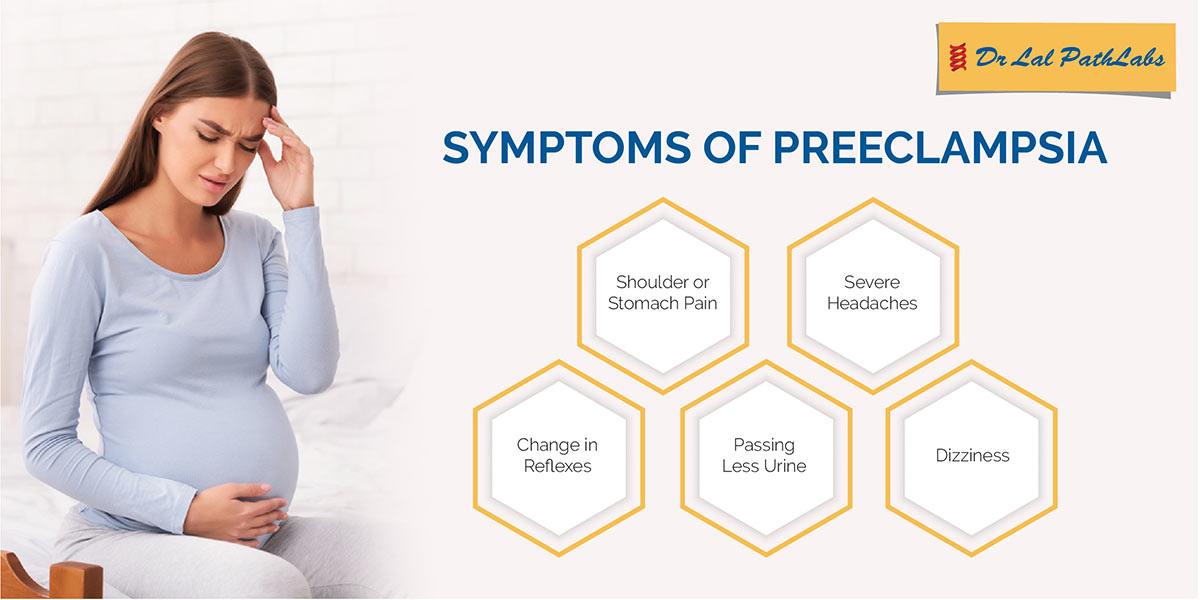Preeclampsia: Symptoms, Diagnosis & Prevention
Overview
Preeclampsia is the most common complication during pregnancy that causes a sudden rise in blood pressure and high levels of protein in the urine. Preeclampsia typically develops after the 20th week of pregnancy and can be dangerous for both the mother and the developing fetus.

The exact causes of preeclampsia are not known, but the following factors may play a role:
- Damage to the blood vessels
- Autoimmune disorders
- Insufficient blood flow to the uterus
- Genetic factors
What are the symptoms of Preeclampsia?
There may be no early signs and symptoms of Preeclampsia.
The preeclampsia signs and symptoms if they occur are:
- Protein in the urine
- High blood pressure
- Blurry vision
- Headaches
- Shortness of breath
- Sudden weight gain
- Swelling in the hands, feet, ankles, and face due to fluid retention
- Pain in the upper abdomen or shoulder
- Lower platelet count
- Nausea and vomiting
- Feeling lightheaded
- Impaired kidney or liver function
What are the risk factors associated with Preeclampsia?
The following risk factors are known to be associated with preeclampsia:
- First pregnancy: The probability of preeclampsia during a first pregnancy is considerably higher than subsequent ones.
- Family history of preeclampsia
- Personal history of preeclampsia: A person who had preeclampsia in their first pregnancy can have a much greater risk of having the same condition in subsequent pregnancies.
- Certain conditions: Conditions such as diabetes, chronic high blood pressure, autoimmune conditions, thyroid disease, and kidney disease make a woman more likely to develop preeclampsia.
- Obesity
- Expecting multiples
- Age older than 35 years
What are the complications caused by Preeclampsia?
If untreated, Preeclampsia can cause serious complications such as:
Hemolysis, elevated liver enzymes, low platelet count (HELLP) syndrome: HELLP syndrome damages red blood cells and affects blood clotting. HELLP syndrome most commonly occurs right after giving birth but can appear at any time after the 20th week of pregnancy. It can also cause chest pain, abdominal pain, and bleeding in the liver.
Poor blood flow to the placenta: This may cause slower growth, breathing difficulties in the baby, and preterm birth.
Placental abruption: Any damage to the placenta may place the baby’s and pregnant woman’s life at risk.
Eclampsia: This is a combination of preeclampsia and seizures. If left untreated, a woman is at risk of coma, permanent brain damage, and death. The condition is also life-threatening for the baby.
How is Preeclampsia diagnosed?
The doctor will do a physical examination and may recommend the following tests to diagnose Preeclampsia:
- Blood tests to assess kidney and liver function, and check how well the blood clots.
- Fetal ultrasound to monitor the growth of the baby and assess the amniotic fluid volume
- Non-stress test to check the baby’s heartbeat when they move.
How is Preeclampsia treated?
The primary treatment for preeclampsia is either to deliver the baby or manage the condition until it is the best time to deliver the baby.
The doctor will frequently monitor the growth and health of the baby. Medications such as antihypertensive drugs, anticonvulsant medication, and corticosteroids may be recommended to treat severe cases of preeclampsia.
What are the tips to prevent Preeclampsia?
Preeclampsia is not fully preventable, but the following tips will help manage and control Preeclampsia:
- Lose some weight if you’re overweight
- Drink plenty of water
- Avoid fried or highly processed foods
- Avoid alcohol, smoking, and caffeine
- Do regular exercise as advised by the doctor
- Keep feet elevated a few times per day
- Get enough sleep
- Get blood pressure or blood sugar under control
Disclaimer:
This blog is for informational purposes only and should not be construed as advice or as a substitute for consulting a physician. It is not a substitute for medical advice or treatment from a healthcare professional.













